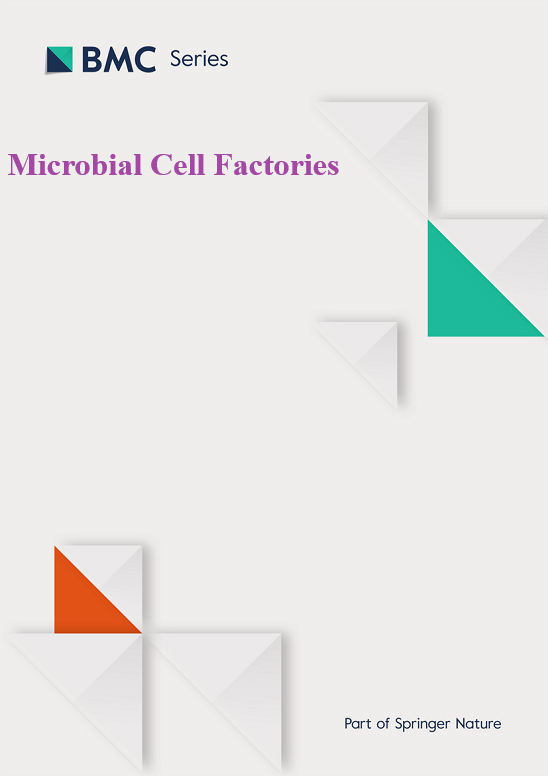利用大肠杆菌的微生物绿色合成发光硫化铽纳米粒子:一种稀土元素解毒机制
IF 4.3
2区 生物学
Q1 BIOTECHNOLOGY & APPLIED MICROBIOLOGY
引用次数: 0
摘要
稀土硫化物纳米粒子(NPs)可利用稀土离子的光学和磁学特性应用于纳米技术。然而,有关其合成的报道很少,而且通常需要高温和较长的合成时间。在此,我们介绍了利用微生物生物合成硫化铽(TbS)NPs 的方法,通过控制细胞硫代谢产生高浓度硫离子,确定了大肠杆菌在 37 °C 水介质中细胞外产生 TbS NPs 的条件。电子显微镜显示出平均直径为 4.1 ± 1.3 nm 的超小球形 NPs。电子衍射表明其结晶度很高,而元素图谱则证实了铽和硫的共定位。这些 NPs 表现出铽元素特有的吸光和发光特性,下移量子产率(QY)达到 28.3%,发射寿命约为 2 毫秒。这种高量子产率和长发射寿命在纯稀土化合物中并不多见;通常与稀土离子掺杂到另一个晶格中以避免非辐射交叉弛豫有关。这表明在这些铽基 NPs 中,非辐射过程的作用有所减弱。据我们所知,这是第一份揭示基于稀土元素(REE)的 NPs 的生物合成比化学合成更具优势的报告,为新的基于稀土元素的纳米晶体开辟了道路。本文章由计算机程序翻译,如有差异,请以英文原文为准。
Microbial green synthesis of luminescent terbium sulfide nanoparticles using E. Coli: a rare earth element detoxification mechanism
Rare-earth sulfide nanoparticles (NPs) could harness the optical and magnetic features of rare-earth ions for applications in nanotechnology. However, reports of their synthesis are scarce and typically require high temperatures and long synthesis times. Here we present a biosynthesis of terbium sulfide (TbS) NPs using microorganisms, identifying conditions that allow Escherichia coli to extracellularly produce TbS NPs in aqueous media at 37 °C by controlling cellular sulfur metabolism to produce a high concentration of sulfide ions. Electron microscopy revealed ultrasmall spherical NPs with a mean diameter of 4.1 ± 1.3 nm. Electron diffraction indicated a high degree of crystallinity, while elemental mapping confirmed colocalization of terbium and sulfur. The NPs exhibit characteristic absorbance and luminescence of terbium, with downshifting quantum yield (QY) reaching 28.3% and an emission lifetime of ~ 2 ms. This high QY and long emission lifetime is unusual in a neat rare-earth compound; it is typically associated with rare-earth ions doped into another crystalline lattice to avoid non-radiative cross relaxation. This suggests a reduced role of nonradiative processes in these terbium-based NPs. This is, to our knowledge, the first report revealing the advantage of biosynthesis over chemical synthesis for Rare Earth Element (REE) based NPs, opening routes to new REE-based nanocrystals.
求助全文
通过发布文献求助,成功后即可免费获取论文全文。
去求助
来源期刊

Microbial Cell Factories
工程技术-生物工程与应用微生物
CiteScore
9.30
自引率
4.70%
发文量
235
审稿时长
2.3 months
期刊介绍:
Microbial Cell Factories is an open access peer-reviewed journal that covers any topic related to the development, use and investigation of microbial cells as producers of recombinant proteins and natural products, or as catalyzers of biological transformations of industrial interest. Microbial Cell Factories is the world leading, primary research journal fully focusing on Applied Microbiology.
The journal is divided into the following editorial sections:
-Metabolic engineering
-Synthetic biology
-Whole-cell biocatalysis
-Microbial regulations
-Recombinant protein production/bioprocessing
-Production of natural compounds
-Systems biology of cell factories
-Microbial production processes
-Cell-free systems
 求助内容:
求助内容: 应助结果提醒方式:
应助结果提醒方式:


